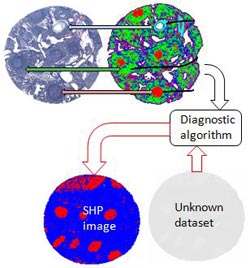Vibrational Molecular Pathology

<br>
During the last 15 years, vibrational spectroscopic methods have been developed that can be viewed as molecular pathology methods that depend on sampling the entire genome, proteome and metabolome of cells and tissues, rather than probing for the presence of selected markers.
The main difference compared to established methods is that no morphological information and no staining reagents are required, since IR and Raman spectra solely rely on molecular and biochemical features that can be probed in a non-destructive way. Pixel by pixel, the inherent spectral signatures of the biochemical components of a tissue can be detected.
In a review article, a team of scientists from the Northeastern University in Boston (USA), the Institute of Photonic Technology in Jena, and the University Jena (Germany) give an overview on the present state of-the-art of “molecular pathology” provided by vibrational micro-spectroscopy. The authors introduce the methodological background and fundamentals and discuss results in the context of spectral histopathology.
Vibrational spectroscopy can be observed in both absorption (IR absorption spectroscopy) or in light scattering (Raman spectroscopy). Every molecule exhibits a distinct and specific fingerprint spectrum in each of the techniques that allows identification and quantitation of the molecular compound. For a complex sample, such as human cells or tissues, the observed IR or Raman spectra are a superposition of all the spectra of the individual biochemical components. Modern mathematical data analysis methods and computer algorithms are able to decode these complex spectral signatures so that the spectral methods are now poised to enter the mainstream diagnostic arena.
The authors report on a number of intriguing results, for example, how metastases could be identified in lymph nodes and brain tissue, and the primary tumor could be determined. Using the vibrational spectroscopy, the source of lymphocyte activation can be traced and different cancer types such as squamous cell carcinoma and adenocarcinoma can be distinguished without the use of morphological information. In addition, it enables the detection of early stage abnormalities of oral and cervical mucosa – useful for screening applications.
Extremely promising for the detection of circulating tumor cells is the fact that different cell types can be distinguished at the single cell level.
The authors also discuss what needs to be done to transfer the vibrational spectroscopic approaches into clinical diagnosis and give an outlook. For example, robust models based on retrospective studies are needed to improve diagnosis and prognosis for new cases; and Raman imaging data acquisition needs a further speed up. Dedicated Raman fiber optic probes for real-time, in vivo applications could even enable optical biopsies before and without surgery.
(Text contributed by K. Maedefessel-Herrmann)
See original publication: M. Diem, A. Mazur, K. Lenau, J. Schubert, B. Bird, M. Miljkoviæ, C. Krafft, and J. Popp; Molecular pathology via IR and Raman spectral imaging, J. Biophotonics 6(11-12), 855-886 (2013) http://onlinelibrary.wiley.com/doi/10.1002/jbio.201300131/abstract
For more information about the Journal of Biophotonics visit the journal homepage.
Regina Hagen
Journal Publishing Manager, Journal of Biophotonics
Managing Editor, Physical Sciences
Global Research
Wiley-VCH Verlag GmbH & Co. KGaA
Rotherstrasse 21
10245 Berlin
Germany
T +49 (0)30 47 031 321
F +49 (0)30 47 031 399
jbp@wiley.com
Media Contact
All latest news from the category: Life Sciences and Chemistry
Articles and reports from the Life Sciences and chemistry area deal with applied and basic research into modern biology, chemistry and human medicine.
Valuable information can be found on a range of life sciences fields including bacteriology, biochemistry, bionics, bioinformatics, biophysics, biotechnology, genetics, geobotany, human biology, marine biology, microbiology, molecular biology, cellular biology, zoology, bioinorganic chemistry, microchemistry and environmental chemistry.
Newest articles

A universal framework for spatial biology
SpatialData is a freely accessible tool to unify and integrate data from different omics technologies accounting for spatial information, which can provide holistic insights into health and disease. Biological processes…

How complex biological processes arise
A $20 million grant from the U.S. National Science Foundation (NSF) will support the establishment and operation of the National Synthesis Center for Emergence in the Molecular and Cellular Sciences (NCEMS) at…

Airborne single-photon lidar system achieves high-resolution 3D imaging
Compact, low-power system opens doors for photon-efficient drone and satellite-based environmental monitoring and mapping. Researchers have developed a compact and lightweight single-photon airborne lidar system that can acquire high-resolution 3D…





















